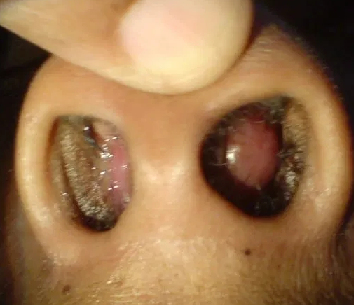
Colección de sangre entre mucopericondrio y tabique cartilaginoso. Es consecutivo a traumatismos que producen ruptura o separación de las estructuras septales con o sin desgarro del mucopericondrio. Se presenta como un engrosamiento localizado o difuso del septum que produce obstrucción de la luz nasal. Debe des ser drenado ya que puede infectarse produciendo necrosis de los cartílagos y perforación o engrosamiento septal cicatrizal.
Sinónimos: hematoma septal.
<(A): Septalhämatom: ist ein Bluterguss oder eine Blutung innerhalb der Nasenscheidewand. Eine gebrochene Nase oder eine Weichteilverletzung in diesem Bereich kann ein Septalhämatom verursachen. Dies kann bei Kindern häufiger auftreten, da die Septumsepten dicker sind und eine flexiblere Auskleidung haben, die den Bereich abdeckt. Eine Verletzung unterbricht die Blutgefässe in diesem Bereich, so dass sich Flüssigkeit und Blut unter der Auskleidung sammeln können. Ihr Arzt oder Ihre Ärztin leitet das Blut sofort ab, indem er oder sie einen kleinen Schnitt in die Auskleidung über dem Hämatom macht. Sobald das Blut entfernt ist, wird Mull oder Watte in die Nase gelegt.
<(F.): Hématome du septum nasal: est une ecchymose ou saignement à l'intérieur de la cloison nasale. Un nez cassé ou une blessure des tissus mous de la zone peut entraîner un hématome septal Cela peut se produire plus souvent chez les enfants parce que leur septums sont plus épais et ont un revêtement plus souple couvrant la zone.Une blessure perturbe les vaisseaux sanguins dans la région, permettant au fluide et le sang de percevoir en vertu de la doublure.
<(Ing): Septal hematoma: is a bruise or bleeding within the nasal septum A broken nose or any soft tissue injury to the area may cause a septal hematoma. This can occur more often in children because their septums are thicker and have a more flexible lining covering the area. An injury disrupts the blood vessels in the area, allowing fluid and blood to collect under the lining. Your health care provider will immediately drain the blood by making a small cut in the lining over the hematoma. Once the blood is removed, gauze or cotton is placed inside the nose.
TÉRMINOS RELACIONADOS:
